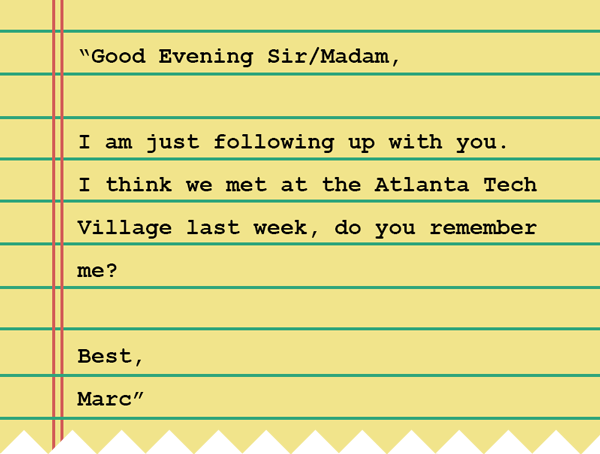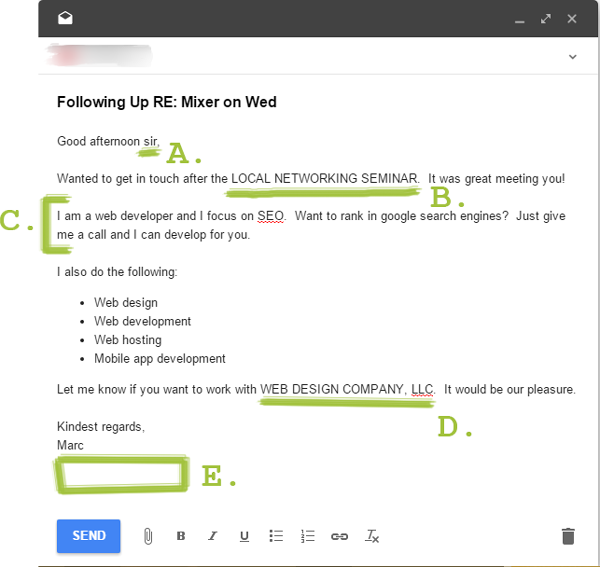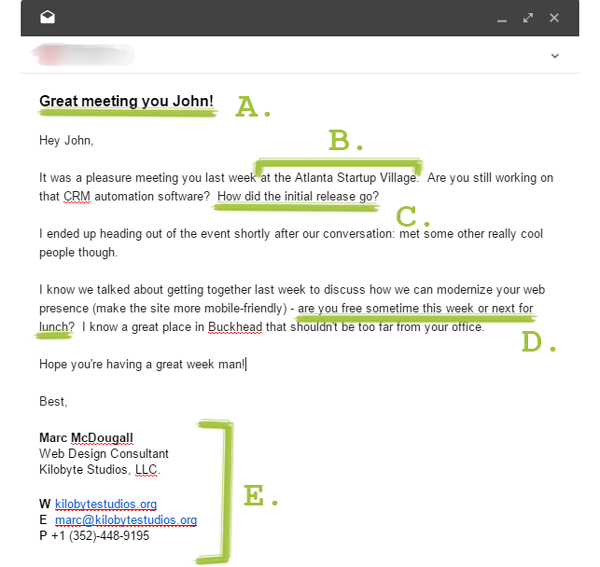Your follow-up after the event is as important as attending the event itself. Some would argue it’s more important because of the context of following up, but that doesn’t matter.
What matters is that it’s going to be the only reliable way you establish meaningful relationships with your potential partners.
Keep in mind again that most people will not even follow-up, and those that do will do it poorly:

In this section, we’ll cover:
- How to effectively follow up with your prospects.
- Specifically, we’ll go over some templates that you can use going forward.
Anyway, let’s get started by first understanding how to follow-up effectively after attending your Atlanta networking events…
Following Up Effectively
There are some tactics that work and others’ that don’t. Fortunately, I’ve tested most of them: here’s my results.
(Pssst. If you have ideas of your own, drop them in the comments!)
| Leverage a CRM
I know, I can hear the gasp from here. All this talk about authenticity and the first item I have on here is to use a Customer Relationship Manager to help with follow-ups.
Here’s the reality: you’re going to be meeting hundreds of people over the next 2 months. If you don’t have a resource in place that helps you to manage that kind of data, some people are naturally going to fall through the cracks.
I use Insightly to manage my relationships (at least when they’re first starting to grow). Think of it as an incubator of sorts.
Here’s exactly what you should use your CRM to do:
- Manage & track contact information.
- Store some metadata about what I can do for the prospect/partner, where I met them, what they enjoy, etc.
- Track the likelihood of conversion (and subsequently understand how much time I should invest relative to other prospects).
- Setup recurring reminders to contact various individuals.
As you can see, all of this information is incredibly-valuable, so you want to make sure that you’re tracking it effectively!
| Follow your Plan
Remember in the previous section you were asked to tell your conversation partner what specifically you were going to do to follow-up? Just do that.
If you said that you were going to reach out the following week and answer their branding questions, do exactly that. People appreciate it when you follow your word.
I will note that I have had much more success waiting a week for a follow-up as opposed to sending it the next day. This is why a CRM is so important: it’s very hard to get this right without a tool to keep you accountable.
| Be Specific
A common mistake when following up is to be too generic about what you want. This gets magnified the more you deal with busier and busier (usually more valuable) contacts.
Here’s a perfect example of what not to do:

As you can see, this person breaks the following rules:
- A: Using “sir” implies you have no idea who this person is. Instead, use their first name.
- B: The all caps here are such a giveaway that a template is being used.
- C: They immediately start talking about themselves.
- D: Again, more templated information.
- E: No way for the prospect to call them if they’d prefer.
Instead, follow these principles:
- Keep it simple.
- Give a general sense of availability.
- For a first meeting, ask for no longer than 30 minutes, ideally less.
- Pick either a concrete time or the location, not both.
- Be explicit with your intentions from the beginning.
Note: Context should trump any of the rules here. If your prospect wants you to go into detail for an hour about how their website could be improved, go for it!
Here’s an example of a great follow up:

Here’s what they did well:
- A: Really personalized subject line. Imagine receiving this – wouldn’t you want to open it up?
- B: Very specific instance depicting where you met the prospect.
- C: Recalling a specific detail of the conversation (“Hey! I’m a great listener.”).
- D: A quick call to action that highlights what you want.
- E: A signature that is simple, yet professionalizes you and lets the prospect either learn more about you or contact you any way they prefer.
Now, the burning question you’re thinking:
“is coffee appropriate for the meeting?”
There’s a ton of debate on this topic for some reason, so I’ll lead with this: it doesn’t matter.
What matters are the above principles…if you’re clear with your intentions and ask for no longer than 20 minutes, it doesn’t matter if you get coffee or go for a ride in a hot air balloon.
| Avoid Obvious Templates
If you haven’t already figured this out, people in the Western world absolutely hate to be sold. The moment someone feels that you’re motivations are more or less selfish, you’ve lost them. This is much more important in the consultant/freelance space than other product-centric businesses.
A template is a great way to lose this trust with your prospect. But this doesn’t mean that you shouldn’t use templates! They play an important role in client relationship management, but you have to do it right.
Here’s a bad example of a template:
![Some words on a notebook that read: "Good Evening Sir/Madam, Great meeting you last week at [LOCATION]! Do you want to meetup next week for coffee? Best, [SIGNATURE]"](https://clarityfirst.co/wp-content/uploads/2014/03/followup-template-bad-e1458783220108.png)
…and here’s a much better example:
![A notebook depicting the text: "Hey [NAME], I believe we met at [LOCATION]: I said I was going to get in touch regarding [TOPIC]. How did [IMPORTANT RECENT EVENT] go? [BRIEFLY ELABORATE] If you still want to meet, I'm free at [DATE/TIME] for [LUNCH/COFFEE]. If that works for you, do you know where we can meet? Anyway, hope all is well [NAME]! Best, [SIGNATURE]"](https://clarityfirst.co/wp-content/uploads/2014/03/email-template-good.png)
Notice the difference? One of them prioritizes efficiency, and the other prioritizes efficacy.
Use a template to get all the boilerplate stuff out of the way (email structure, signature), but when it comes to the content, write it yourself so you at least have a chance of your authenticity showing through.
All in all, following up is just as important as networking itself (and you get to do it from the comfort of your computer!), but you have to do it well or you might as well have not even attended the event.
Now, we’ve covered an incredible amount of detail within the domain of networking, so in the next section we’re going to distill it down into some key takeaways.
We’re almost done! Onward!